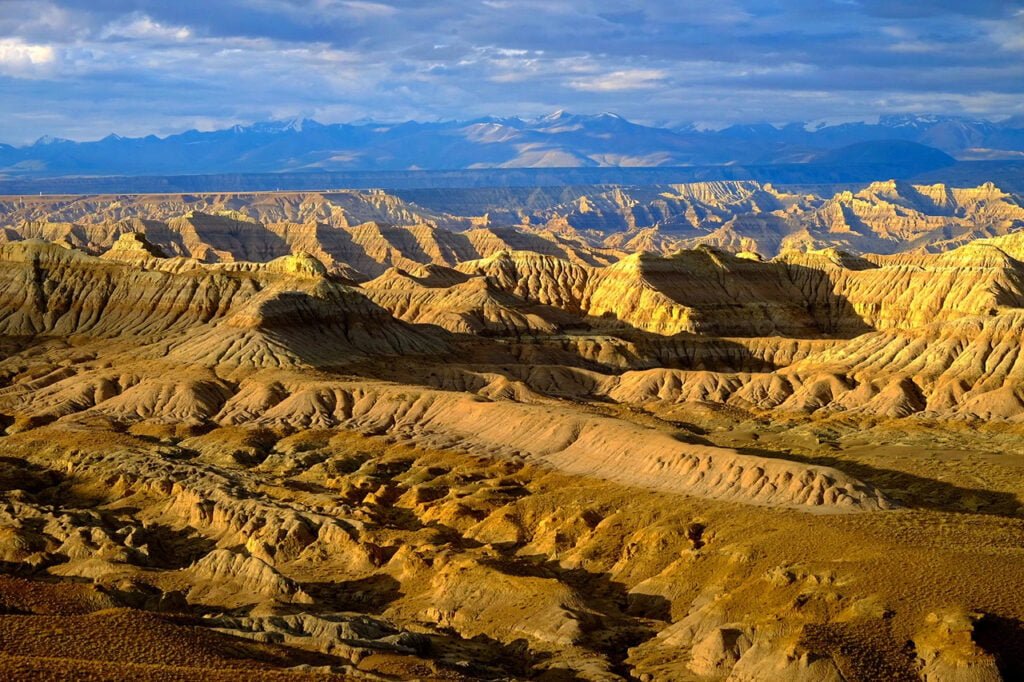If you’re a nature enthusiast or simply someone seeking extraordinary landscapes, the Zhada Earthen Forest in the Ngari Region is a place that should undoubtedly be on your travel list. As a typical example of typography, this unique natural wonder can be rightly called a masterpiece crafted by the hands of nature itself. Not only is it one of the most exceptional geological formations in China, but it’s also the only one of its kind globally. This article will take you on a journey through the fascinating Zhada Earthen Forest, a place of unparalleled beauty and geological significance.
A Geological Marvel
The Zhada Earthen Forest is located in the vicinity of the Langchen Tsangpo, also known as the Indus River. Covering an impressive area of 5,000 square kilometres, with the core region spanning 800 square kilometres, it’s a geological marvel that leaves visitors in awe. The most spectacular earthen forests are found in the Zhada Gully and Sangda Gully, which are considered the crown jewels of this breathtaking landscape. In 2005, it was rightfully designated as a National Geographic Park, recognizing its immense value to geology and tourism.
The Forces of Nature at Work
The formation of the Zhada Earthen Forest can be attributed to the orogenic movements of the Himalayas. These movements caused the lakebed to rise, creating the perfect conditions for the development of this mesmerizing landscape. Over time, the earth here has been sculpted by the relentless forces of water, wind, and weathering. Walking through these narrow earthen forests feels like stepping into the remnants of an ancient kingdom, offering a mix of desolation and magnificence that’s truly enchanting.

Discovering Zhada County
Zhada County, which translates to “the place where there is grass in the lower reaches of the river” in Tibetan, is a county situated within Nagri Prefecture. This region is also home to the renowned Tuolin Monastery and the remnants of the Guge Kingdom. When you enter Zhada County, you’ll be greeted by clay forests flanking both sides of the Elephant Spring River, stretching for over five kilometres. The clay formations here take on various shapes, some resembling warriors defending mountaintops, others resembling galloping horses, and still, some mimic devout followers in meditation. Each perspective offers a different and captivating view of the landscape.
Geological Significance
Geologists classify the Zhada Earthen Forest as “the Level Terrane Physiognomy,” formed primarily by the erosive action of water. The sediment strata consist of sandstone and clay, and the region’s unique geological features make it stand out. The combination of upright quality and the sandstone’s remarkable resilience gives rise to deep valleys and canyons that can reach depths of 100 to 200 meters, making this landscape truly spectacular.
An Ancient Legacy
The mystical and peculiar physiognomy of the Zhada Earthen Forest extends throughout Zhada County. During the reign of the Shang Shung and Guge Kingdoms, people utilized the natural resources provided by this unique landscape to carve caves for habitation. More than 400 caves created by Tibetan ancestors can still be found within the clay forest, forming an intriguing ancient architectural complex.
How to Get There
Visiting the Zhada Earthen Forest is an adventure worth embarking on. You can start your journey from Sengay Tsanpo, covering a distance of 255 kilometres. Hiring a car for a three or four-day round trip, with a daily cost of 800 yuan, is a convenient option. The earthen forests are conveniently close to the Zanda County seat and can even be reached on foot from there.
Exploring the Zhada Earthen Forest: A Natural Masterpiece
The Earth Forest landform in Zanda, China, is a testament to the awe-inspiring diversity of nature’s craftsmanship. This geological wonder is a true masterpiece, offering a breathtaking spectacle of various landform types, each with its distinct characteristics. From the grandeur of the Aquarius-style earth forest to the delicacy of the nose-shaped soil forest, the Zanda Earth Forest boasts an array of formations that reflect the dynamic changes in the Zanda Basin.
A Landscape Shaped by Legends and Science
Legend has it that in ancient times, the Zanda area was submerged beneath a vast ocean. While this may sound like a mythical tale, it holds some scientific truth. Research indicates that the region was once covered by a massive lake, stretching over 500 kilometres in radius. However, due to the Himalayan orogeny, the lake basin gradually rose, causing a decline in water levels. The exposed mountain rocks were then subjected to the erosive forces of wind and rain, ultimately resulting in the unique and striking landscape we see today.
The Geological Marvel of Earth Forests
In geomorphological terms, the Earth Forest is referred to as a “horizontal rock formation.” It is a distinctive secondary landform created through the erosion of water. Comprising sedimentary strata from Pliocene lakes and rivers, with depths of up to 800 meters, the Earth Forest is primarily composed of fine siltstone and claystone, occasionally interspersed with coarse sandy conglomerate. The sandstone and conglomerate, known for their dense and sturdy structures, often serve as protective layers, resting horizontally atop the rock walls or extending outward, interacting with the softer rock layers. This interaction gives rise to majestic, towering, and vividly coloured rock formations, reminiscent of ancient castles, city walls, and towers.
A Living History
During the Zhangzhong and Guge periods, the people of the region dug caves within the Earth Forests to establish their homes and kingdoms. More than 400 caves, created by their Tibetan ancestors, can still be explored within the Earth Forest, forming a complex of ancient buildings, predominantly in the Xiangquan River Basin. This Earth Forest is not just a geological wonder; it holds immense historical and aesthetic value, making it a unique attraction in Zanda County.
Nature’s Imagination Unleashed
Visiting the Earth Forest is a journey into nature’s boundless imagination. The hills within this landscape resemble castles, and the ravines etched across them display distinct lines, reminiscent of soldiers in formation or officials meeting the emperor. The rock formations take on the appearance of galloping animals, ferocious totems, and more. In short, the Earth Forest is a place where you can find anything your imagination can conjure.
Tour Tips
- Location: Zanda Tulin National Geopark is situated on the border of Purang County to the east, Kashmir to the west, the Himalayas to the south, the border with India, and Ayila Mountain to the north and Gar County. The main geological relics here are the soil and forest landforms.
- Accessibility: Zanda Tulin National Geopark is located approximately 1,500 kilometres from Lhasa City and 280 kilometres from Shiquanhe Town, where the Ali Prefecture Administrative Office is situated. It is easily accessible via an asphalt road.
When you step into the Zanda Earth Forest, you’ll be enchanted by the enigmatic beauty that nature has carved into this remarkable landscape. It’s a destination that promises to leave you in awe, both with its geological wonders and its historical significance.
Conclusion
The Zhada Earthen Forest is an incredible testament to the power of nature. Its unique geological formations, rich history, and breathtaking vistas make it a must-visit destination for travellers and geology enthusiasts alike. Explore the Zhada Earthen Forest and witness the wonders of nature in their most magnificent form.
Frequently Asked Questions (FAQs)
1. What is the significance of the Zhada Earthen Forest in China? The Zhada Earthen Forest is not only a remarkable geological formation but also the only one of its kind in the world. Its geological importance and unique beauty earned it the title of a National Geographic Park in 2005.
2. How did the Zhada Earthen Forest form? The orogenic movements of the Himalayas played a pivotal role in the formation of the Zhada Earthen Forest. These movements caused the lakebed to rise, allowing for the creation of this extraordinary landscape through the action of water and weathering.
3. What can visitors expect to see in Zhada County, aside from the earthen forest? Zhada County is home to the Tuolin Monastery and the ruins of the Guge Kingdom. Additionally, you can explore the fascinating clay formations along the Elephant Spring River, each with its unique and captivating shapes.
4. What is the geological classification of the Zhada Earthen Forest? Geologists classify the Zhada Earthen Forest as “the Level Terrane Physiognomy.” This classification is due to the erosive action of water on the sediment strata, primarily composed of sandstone and clay.
5. How can I reach the Zhada Earthen Forest for a visit? You can start your journey from Sengay Tsanpo, covering a distance of 255 kilometres. Hiring a car for a three or four-day round trip is a convenient option, with a daily cost of around 800 yuan. The earthen forests are conveniently close to the Zanda County seat and can even be reached on foot from there.



